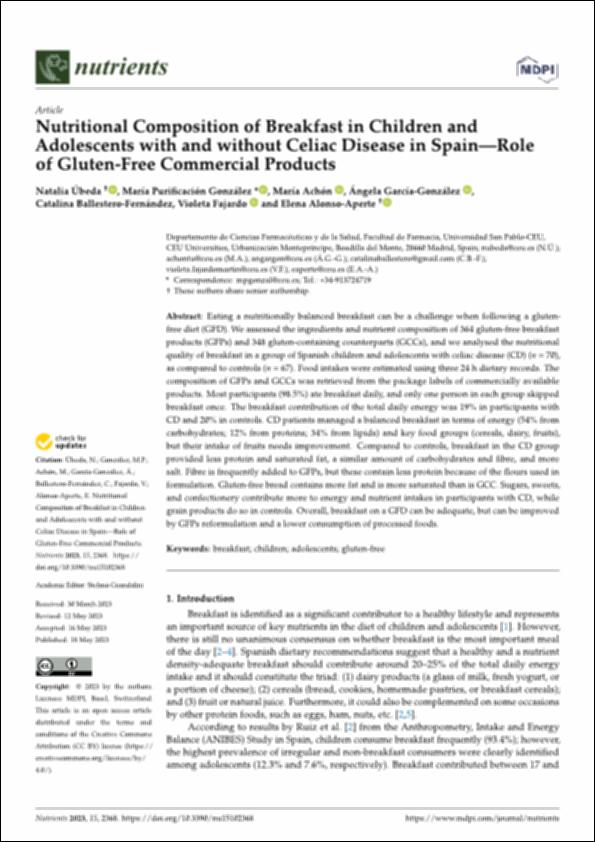Please use this identifier to cite or link to this item:
http://hdl.handle.net/10637/14906Nutritional Composition of Breakfast in Children and Adolescents with and without Celiac Disease in Spain—Role of Gluten-Free Commercial Products
| Title: | Nutritional Composition of Breakfast in Children and Adolescents with and without Celiac Disease in Spain—Role of Gluten-Free Commercial Products |
| Authors : | Úbeda Martín, Natalia González González, María Purificación Achón y Tuñón, María García González, Ángela Ballestero Fernández, Catalina Fajardo Martín, Violeta Alonso Aperte, Elena |
| Keywords: | Breakfast; Children; Adolescents; Gluten-free |
| Publisher: | MDPI |
| Citation: | Nutritional Composition of Breakfast in Children and Adolescents with and without Celiac Disease in Spain-Role of Gluten-Free Commercial Products. Úbeda N, González MP, Achón M, García-González Á, Ballestero-Fernández C, Fajardo V, Alonso-Aperte E. Nutrients. 2023 May 18;15(10):2368. doi: 10.3390/nu15102368.PMID: 37242250 |
| Abstract: | Eating a nutritionally balanced breakfast can be a challenge when following a glutenfree diet (GFD).We assessed the ingredients and nutrient composition of 364 gluten-free breakfast products (GFPs) and 348 gluten-containing counterparts (GCCs), and we analysed the nutritional quality of breakfast in a group of Spanish children and adolescents with celiac disease (CD) (n = 70), as compared to controls (n = 67). Food intakes were estimated using three 24 h dietary records. The composition of GFPs and GCCs was retrieved from the package labels of commercially available products. Most participants (98.5%) ate breakfast daily, and only one person in each group skipped breakfast once. The breakfast contribution of the total daily energy was 19% in participants with CD and 20% in controls. CD patients managed a balanced breakfast in terms of energy (54% from carbohydrates; 12% from proteins; 34% from lipids) and key food groups (cereals, dairy, fruits), but their intake of fruits needs improvement. Compared to controls, breakfast in the CD group provided less protein and saturated fat, a similar amount of carbohydrates and fibre, and more salt. Fibre is frequently added to GFPs, but these contain less protein because of the flours used in formulation. Gluten-free bread contains more fat and is more saturated than is GCC. Sugars, sweets, and confectionery contribute more to energy and nutrient intakes in participants with CD, while grain products do so in controls. Overall, breakfast on a GFD can be adequate, but can be improved by GFPs reformulation and a lower consumption of processed foods. |
| URI: | http://hdl.handle.net/10637/14906 |
| Rights : | http://creativecommons.org/licenses/by/4.0/deed.es OpenAccess |
| ISSN: | 2072-6643 |
| Issue Date: | 18-May-2023 |
| Center : | Universidad San Pablo-CEU |
| Appears in Collections: | Facultad de Farmacia |
Items in DSpace are protected by copyright, with all rights reserved, unless otherwise indicated.


